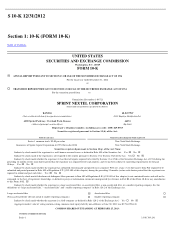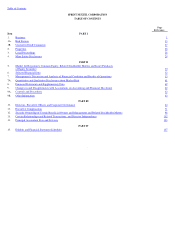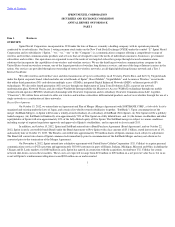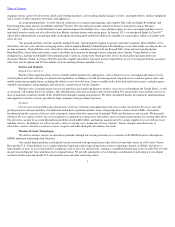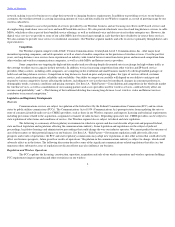Sprint - Nextel 2012 Annual Report Download - page 11
Download and view the complete annual report
Please find page 11 of the 2012 Sprint - Nextel annual report below. You can navigate through the pages in the report by either clicking on the pages listed below, or by using the keyword search tool below to find specific information within the annual report.
Table of Contents
required under the terms of the Report and Order, a letter of credit has been secured to provide assurance that funds will be available to pay the
relocation costs of the incumbent users of the 800 MHz spectrum. We submit the qualified 800 MHz relocation costs to the FCC for review for potential
letter of credit reductions on a periodic basis. As a result of these reviews, our letter of credit was reduced from
$2.5 billion
at the start of the project to
$859 million
as of
December 31, 2012
, as approved by the FCC. As required by the Report and Order, the letter of credit had a minimum of $850 million,
which was largely intended to protect both the relocating licensees as well as the US Treasury should an anti
-
windfall payment be necessary. Given
the significant progress that has been made, the total amounts spent to date, and the remaining forecasted amounts to be spent by the licensees,
Sprint believes it is reasonable to allow the letter of credit to be reduced below $850 million. Accordingly, in January 2013, we submitted a Request for
Declaratory Ruling to the FCC requesting two items: (i) that it declare that Sprint will not owe any anti
-
windfall payment to the US Treasury, because
we have exceeded the $2.8 billion of required expenditures, and (ii) that the FCC remove the $850 million minimum for the letter of credit and allow
further reductions based on quarterly estimates of remaining obligations. This Request for Declaratory Ruling is pending before the FCC.
Completion of the 800 MHz band reconfiguration was initially required by June 26, 2008. The FCC continues to grant 800 MHz public safety
licensees additional time to complete their band reconfigurations which, in turn, delays our access to some of our 800 MHz replacement channels.
Accordingly, we will continue to transition to our 800 MHz replacement channels consistent with public safety licensees' reconfiguration progress. We
anticipate that continuing reconfiguration progress will be sufficient to support the 800 MHz portion of our Network Vision rollout. On May 24, 2012,
the FCC revised its rules to authorize Sprint to deploy wireless broadband services, such as CDMA and LTE, on its 800 MHz spectrum, including
channels that become available to Sprint upon completion of the 800 MHz band reconfiguration program.
New Spectrum Opportunities and Spectrum Auctions
Several FCC proceedings and initiatives are underway that may affect the availability of spectrum used or useful in the provision of
commercial wireless services, which may allow new competitors to enter the wireless market. While in general we cannot predict when or whether the
FCC will conduct any spectrum auctions or if it will release additional spectrum that might be useful to wireless carriers, including us, in the future, the
FCC has taken steps to license spectrum designated for auction in the Middle Class Tax Relief and Job Creation Act of 2012. In particular, the FCC has
initiated two proceedings to auction the Advanced Wireless Services H Block and to reallocate and auction broadcast spectrum in the 600 MHz Band.
911 Services
Pursuant to FCC rules, CMRS providers, including us, are required to provide enhanced 911 (E911) services in a two
-
tiered manner.
Specifically, wireless carriers are required to transmit to a requesting public safety answering point (PSAP) both the 911 caller's telephone number and
(a) the location of the cell site from which the call is being made, or (b) the location of the subscriber's handset using latitude and longitude, depending
upon the capability of the PSAP. Implementation of E911 service must be completed within six months of a PSAP request for service in its area, or
longer, based on the agreement between the individual PSAP and the carrier. The FCC is currently reviewing the accuracy standards for the provision
of wireless 911 services indoors and may impose additional obligations, but we believe we comply with current requirements.
National Security
National security and disaster recovery issues continue to receive attention at the federal, state and local levels. For example, the new
Congress is expected to again consider cyber security legislation to increase the security and resiliency of the Nation's digital infrastructure. It is also
understood that the President may issue an Executive Order directing the Department of Homeland Security and other government agencies to take a
number of steps to improve the security of the Nation's critical infrastructure. We cannot predict the cost impact of such measures. In addition, the
FCC continues to examine issues of network resiliency and reliability, particularly in the wake of the weather
-
related disasters that struck the U.S.
mainland in 2012 and may seek to impose additional regulations designed to reduce the severity and length of disruptions in communications. Again,
we cannot predict the cost impact of any regulations the FCC adopts. The FCC, in conjunction with the Federal Emergency Management Agency and
Department of Homeland Security, may also seek to enhance wireless emergency alerting systems. Sprint has been providing such emergency alerts
since January 2012.
8

